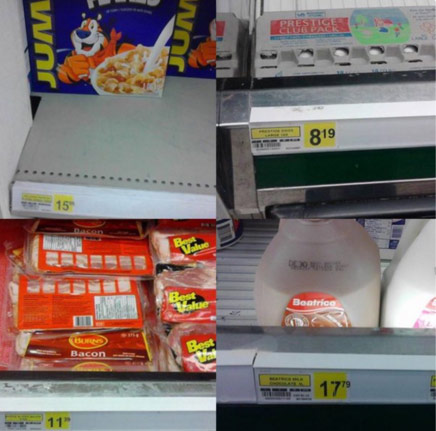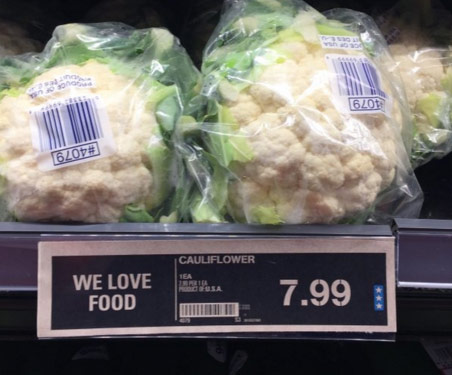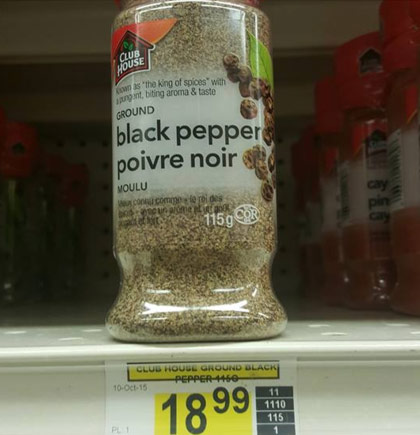This article was originally published by Joshua Krause at Tess Pennington’s ReadyNutrition.com.
![]() Editor’s Note: Though the US Dollar is stronger now than it has been in recent memory, the massive monetary easing from the Federal Reserve will eventually come to a head. As Joshua Krause notes in the article below, we are already see signs of inflation here in the United States but nothing of the sort we can expect when the all of those printed US Dollars are released into the open market. It will be a deluge and one that will lead to rapid price increases across the board, especially in essential goods. For evidence of how a currency collapse will play out look no further than our northern neighbors, where Canadians are now paying $32 (CAD) for a bottle of Tide, $15 (CAD) for a box of Frosted Flakes and $12 for a package of bacon. Can you imagine that scenario in the United States?
Editor’s Note: Though the US Dollar is stronger now than it has been in recent memory, the massive monetary easing from the Federal Reserve will eventually come to a head. As Joshua Krause notes in the article below, we are already see signs of inflation here in the United States but nothing of the sort we can expect when the all of those printed US Dollars are released into the open market. It will be a deluge and one that will lead to rapid price increases across the board, especially in essential goods. For evidence of how a currency collapse will play out look no further than our northern neighbors, where Canadians are now paying $32 (CAD) for a bottle of Tide, $15 (CAD) for a box of Frosted Flakes and $12 for a package of bacon. Can you imagine that scenario in the United States?
Analyst Greg Mannarino has warned that when the debt bubble collapses there is a real possibility that millions of people will die because those goods essential to survival will simply be unattainable for the masses. When the cost of food becomes 50% or more of your income, it’s not that difficult to imagine such a scenario happening.
Canadians Are Panicking Over Food Costs After Currency Collapse
By Joshua Krause (ReadyNutrition.com)
It’s no secret that America has a serious inflation problem. Though the Federal Reserve insists that our inflation rate is only at around .5%, we’ve all seen the price of food, rent, healthcare, and energy skyrocket over the past 10-20 years. However, this has been a gradual shift. Northern Canada on the other hand, has just seen the price of every day goods rise precipitously over a very short period of time.
The crash in oil prices has crippled their economic growth, and led to the decline of the Canadian dollar, as well as a predictable increase in the cost of imports like food. For those of us living in the US, this provides a really good example of what life may be like should the dollar take a plunge in the near future. Here’s what our northern neighbors have been dealing with:
It is often said that a free-floating currency acts as a shock absorber.
But when Canadians go shopping for groceries these days, they’re getting nothing but the shock—sticker shock, that is.
On Tuesday, the Canadian dollar, commonly known as the loonie, broke below 70 U.S. cents for the first time since May 1, 2003.
For America’s northern neighbor, which imports about 80 percent of the fresh fruits and vegetables its citizens consume, this entails a sharp rise in prices for these goods. With lower-income households tending to spend a larger portion of income on food, this side effect of a soft currency brings them the most acute stress.
James Price, director of Capital Markets Products at Richardson GMP, recently joked during an interview on BloombergTV Canada that “we’re going to be paying a buck a banana pretty soon.”
These three old lessons will ensure your children will be well fed when others are rummaging through garbage bins. Click here to learn all about the 3 skills that will help you thrive in any crises situation.
Northern canadians took to twitter this week to share their collective horror over the rising cost of food. Cucumbers are $3 each. A head of cauliflower is $8. A large container of pepper cost $19 and some Canadians are paying $16 for a single bell pepper. A container of laundry detergent is $32.




This gives us a pretty good idea what would happen in the US, even if there was a minor shock to the value of the dollar. Despite the rising cost of goods and services, our currency has been doing really well on the global stage for the past two years. I shudder to think of what will happen when our economy runs into another recession, which we are way overdue for. When it does hit, the cost of our imports will rise the most, much like they have in Northern Canada.
So what are our main imports? Fortunately, most of our food is homegrown, but there are quite a few American food staples that are also raised abroad, such as bananas, coffee, nuts, and seafood. And even though we’re one of the world’s largest meat producers, we still import a lot of pork and beef from Canada, New Zealand, and Australia. However, that doesn’t mean homegrown food wouldn’t become more expensive as well.
Even though we’ve become one of the world’s leading oil and natural gas producers in recent years, we still import a significant amount of oil from abroad. Since our agricultural industry is heavily reliant on oil, we could expect the price of all our foods, both domestic and imported, to rise.
If you want to understand how our economy would hurt from inflation or a dollar dump, take a look a this list of America’s biggest imports. We ship in a ton of electronics, which are worth about $315 billion per year. For a high-tech society like ours, this would be crippling.
The other items that stand out in that list are healthcare related. When put together, medical equipment and pharmaceuticals amount to 6.3% of our imports. Our medical system is already the most expensive in the world, so a plunge in the dollar’s value would make that situation significantly worse.
All told, a dollar dump would be really bad. That may sound obvious, but when it happens you can expect our government and media to tell us the same thing the leaders in Canada are trying to tell their citizens. Here’s how Steven Poloz, the head of Canada’s central bank, is trying to spin this situation.
Nonetheless, Mr. Poloz insisted that the Canadian dollar, which has plunged to near 70 cents (U.S.), is helping to offset the billions in lost revenue from exports of oil and other commodities. The drop makes Canada’s non-resource exports more competitive in world markets. A lower dollar is generally beneficial to exporters because they pay for their inputs, such as labour, in Canadian dollars, while their sales are generated in the higher U.S. dollar.
This is how all central bankers talk. They could find a silver lining in any situation, even if there was blood in the streets. They’ll say the same thing in the US when the next recession hits and the dollar slips. But it won’t change the fact that everything we need for our survival will be more expensive, and the average person will be making less (or no) money.
I will unearth a long-forgotten secret that helped our ancestors survive famines, wars, economic crises, diseases, droughts, and anything else life threw at them… a secret that will help you do the same for your loved ones when America crumbles into the ground. Watch VIDEO
_____________________________________________________________________
OTHER USEFUL RESOURCES!
Blackout USA (EMP survival and preparedness guide)
Bullet Proof Home (A Prepper’s Guide in Safeguarding a Home )
Backyard Innovator (All Year Round Source Of Fresh Meat,Vegetables And Clean Drinking Water)
Conquering the coming collapse (Financial advice and preparedness )
Liberty Generator (Easy DIY to build your own off-grid free energy device)
Backyard Liberty (Easy and cheap DIY Aquaponic system to grow your organic and living food bank)
Family Self Defense (Best Self Defense Strategies For You And Your Family)
Sold Out After Crisis (Best 37 Items To Hoard For A Long Term Crisis)
US Water Revolution (Generate Your Clean Water Anywhere)
Alive After The Fall (Key Survival Situation Procedures and Knowledge )
Mega Drought USA:(Discover The Amazing Device That Turns Air Into Water)
Survive The End Days (Biggest Cover Up Of Our President)
Survival MD (Best Post SHTF Medical Survival Guide Ever)
Joshua Krause was born and raised in the Bay Area. He is a writer and researcher focused on principles of self-sufficiency and liberty at Ready Nutrition. You can follow Joshua’s work at our Facebook page.

I wish you Americans would quit using the example of high food costs from stores north of the arctic circle!!! Food costs have always been extremely high there because of the cost of transportation. For most of Canada…while costs are marginally higher…it is quite tolerable….some items have gone down in price.
Hi Paul, yes I wondered the same when the pictures said Northern Canada. Transport costs exponentially raise the cost of goods, such as when we were in the Cayman Islands where it costs hundreds more per trip to the grocery store. Also if the exchange rate is computed, then the detergent is about $22 same as in America. That said, I do see a lot of merit in the tone of the article and our meat prices have skyrocketed due to the preventable drought in the regulation nation of CA and multiple herds being wiped out in the Dakotas and TX due to these engineered weather abberations. Stay safe my friend, it’s going to be an interesting year for all of us.
Thank you. although food price have gone up, but nothing like what is implied in the article. The prices you see in the Twitter feeds are all small northern town where supplies have be flown in, or take days to drive In. The Twitter campaign has more to do with getting the government to subsidize food to the north then it has with prices going up. Canadiens are not freaking out over a dollar collapse, most are clueless and 40% drop in our dollar means little. Drop in oil prices on the other hand is really taking its tole. That said I know fist hand that the powers at be in Canada are freaking out over our situation, everyone should be prepping.
I live in Manitoba, one of Canada’s prairie provinces. I consider Manitoba to be a ‘western’ province, but my eastern friends assure me that only Alberta and British Columbia qualify as ‘western’.
These as-found prices are probably real, but are anomalies, and do not accurately reflect retail prices. For example, we purchase equivalent laundry soap on sale for $4, and would never at any time consider purchasing Tide, which is always over-priced.
My wife does the grocery shopping, and avers that general prices are up about 15% to 20% this past year, which is substantial, but not earth-shattering. She does not purchase fresh vegetables because they are too expensive, and substitutes canned or frozen veggies. Pepper is far cheaper on average than shown in the article, though a similar size peppercorns is about $12, though ground pepper, especially white pepper, is far cheaper.
We are frugal, and shop wisely, but the depreciating Canadian dollar is having an effect. I note prices creeping up in hand tools, automobile parts, etc., but not to the levels exaggerated in similar articles. My best guess is that consumer products are up about 15 percent this past year, and articles like this are merely fear porn.
tide is way too high here in the states. i’ve seen the same size tide in stores here for $14.00 +. when i saw the price for tide i thought to myself “they must be making tide out of gold these days”. i’m in maine. meat here is cheaper than in texas. everything is cheaper here than in texas. we have farmers markets in summer that are great. we have co-ops here with great prices. the llittle mom and pop groceries are cheaper with better quality on most things than walmart.
Northern Canada Territories have always had out of site prices, with the cost to flying goods into remote isolated locations. This doesn’t reflect the rest of Canada. People living in these location are subsidized by the government for the high cost of transportation.
Your facts are a bit misleading. Some of the really high prices you show are in the Northern Territories that traditionally pay more because of their isolation. It cost more to ship food there, so for that reason the higher cost. They have no big box stores that sell cheaper bulk items that compete to keep prices more grounded. It’s still a lot to pay probably too much, but that;s what happens.
As for our falling dollar, it’s happened before. The higher food prices we pay for vegetables and meat products are more geographical. We only have one growing season. During that season we always see a return to normality in vegetable and fruit prices. For Canadians this is normal. Beef and pork prices stay high because of the devastation from weather and disease of the herds.
The goods we export are more attractive to other countries and that creates employment and other revenue steams for our Country.
Our main oil reserves are in Alberta. I admit it has been hit hard. all the other parts of the country are almost status Qua. Fishermen are finding it tough because of die offs and deep sea draggers, but Canada is highly diversified. We don’t have all our eggs in the same basket.
Canada is so full of itself that it will never admit what an American has to say about the country is true. So Canada settles for and is perfectly happy with generic everything. Good for Canada.
Maybe because we see ourself that the prices are not that high. Prices have increased a little but not that bad. (i bought cauliflowers 2$ each yesterday near Montreal Qc, to give you an example) Those pictures were taken in Nunavut and the prices are very high because some places have no roads to get there. The stores get their stock by plane
I live in Canada and I am 62 years old. It seems every alternative media site is falling for this story. When I got out of high school grade 12 in the early 1970’s it was common practice for many of us graduates to take a year or more to make some fast money to buy a new or used car or other things by working up north. Let me be very clear here: THERE ARE NO ROADS UP NORTH and the ONLY way to get goods up there is by plane. That is expensive. Yes , prices shown in this article are very high but they were equally high back in the 1970’s and every year on up to present day. About 99.999% of Canada’s population lives along the southern border. If you want to make a lot of money you go north where you work 12 hour days in brutal conditions. This is nothing new and it will probably continue for decades to come. Canadians are not in a panic over food and there is no crisis. Businesses up north fly workers up to their sites and pay them wages not seen in the south. They feed you like a king and the high prices are compensated for. The prices where most of us live are comparable to US prices and inflation is the same as you see in your stores. This story has been all over the internet and is completely misleading.
The “inflated” prices shown are in Canadian dollars, not USD. Do the math and it’s not that bad.
Thank you, folks in Canada. I live in USA and rather than take the word of a random article, I reasearch. Sales fliers at Canadian stores reflect prices much lower than these few items that keep getting recirculated by someone trying to cause panicked in people. Things aren’t great anywhere, but please don’t assume just because you see it on the Internet that it is fact.
I guess having free medical coverage here in Canada offsets the cost of food.
you should compare with prices in the north of Alaska. Also some of northern cities in Canada need plane transportation for the food and products, that’s why the prices are so high. Remeber those pictures were taken in Nunavut.
We are very close to the time to stock up on the loonie if not already there. An old Wall Street axiom: “Buy when the blood is running in the street.” Seen several articles like this recently. The more we see the closer to the bottom we are.
Northern Canada has to have all it’s food flown in, food prices really haven’t shot up that much. Froster Flakes were always $12 in Northern Canada, so it’s gone up a bit.
The rest of Canada isn’t noticing too big of price changes.